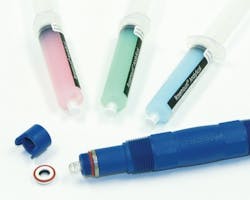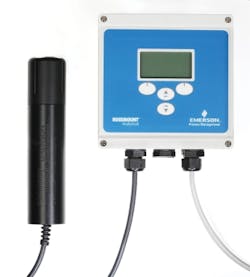By Pete Anson
Current trends in wastewater treatment focus on reducing costs and maintenance requirements, improving efficiency and productivity and lowering energy usage. Key developments include wireless technologies, new advanced sensor diagnostics, ways to reduce energy costs with effective analysis, and rebuildable capabilities that extend sensor life and reduce maintenance requirements. These help plant operators safeguard water quality, while reducing labor and costs and improving regulatory compliance.
Wireless Technologies
One of the most significant trends in the treatment of wastewater is the increasing adoption of wireless technologies. With the growing number of wastewater treatment plant expansions and renovations across the country, there's an opportunity to introduce wireless into plant networks inexpensively and conveniently.
Currently such measurements as pH and conductivity are available in wireless analytical instruments, as are pressure and temperature measurements. Traditionally, analyzers located in critical processes have been connected to the plant's central network and asset management systems through wired connections that are costly to install. More often, liquid analyzers are installed in remote or hazardous locations where wiring into a central network is inconvenient and expensive, so they often aren't integrated at all. The data and internal diagnostics on these isolated instruments must be accessed on-site by an operator, increasing costs and reducing efficiency.
Wireless analytical instruments can be integrated with other wireless measurements like pressure and temperature and connected to the plant's existing network and asset management systems so that vital data can be captured continuously and automatically without the risk of human error. New wireless adaptor devices are also available that allow non-wireless devices to connect to the plant network.
Advanced pH Diagnostics
Wireless integration enables plants to take advantage of advanced diagnostic data available in today's instruments, such as pH slope, reference offset, glass impedance and reference impedance. These advanced diagnostics flag operators when a sensor is performing marginally or failing, allowing plants to estimate probe life and plan maintenance schedules based on live data rather than replacing or cleaning sensors more frequently than required. Predictive diagnostics free up time for technicians, as many plants now have fewer resources as a result of retirement or cost-cutting measures.
Wireless analyzers can communicate sensor diagnostic data and multiple process variables via WirelessHART digital protocol to the plant process control system, enabling operators to monitor the sensor condition and detect abnormal conditions remotely before they cause a major problem, reducing maintenance costs and improving productivity. Current wireless technology can be enabled on existing analyzers with easily installed wireless adaptors that don't require additional software or major systems integrations or batteries.
The combined ability of advanced sensor diagnostics and wireless technologies can also help address a critical need facing many industrial and municipal wastewater treatment plants today - how to offset the loss of in-house expertise as senior plant personnel retire. As more experienced plant operators retire, plants are finding they need to replace that institutional knowledge of technologies, field processes and plant operations. A current trend is for plants to draw on external expertise, to help train staff and assist in knowledge transfer. Some suppliers not only provide training on the best use of their equipment, but also perform tasks the plant operators may no longer have the expertise for in-house.
Sensors
One of the areas where new technologies are being implemented is in primary treatment processes where the solids are mechanically, physically or chemically separated from the liquid. Starting with influent treatment, plants must monitor the influent pH and conductivity measurements to detect possible upset conditions. The ideal influent pH range is between 6 and 9 as a higher pH is harmful to the microorganisms used to break down the wastewater and a lower pH will damage concrete. Since lime will gradually coat the pH sensor surface during primary treatment applications, new pH sensor technologies are designed to be coating-resistant by incorporating a large reference junction. A large surface area and high porosity provide a stable contact to the process to help resist coating, providing a longer sensor life with minimal maintenance. If coating does occur, today's sensors are designed so that the reference electrode can be rebuilt by simply replacing a clogged reference junction and recharging the electrolyte, significantly reducing maintenance and replacement costs.
Conductivity and ORP measurements are also important in primary treatment processes. A sudden change in influent conductivity may indicate an unusual discharge upstream from an industrial plant. A toroidal conductivity sensor with a large-bore sensor design is ideal in this process as it resists plugging and fouling and a metal frame reinforces the mounting shaft to withstand harsh conditions, reducing maintenance and sensor replacement costs. In addition, a sharp decrease in influent ORP readings indicates an increase in strength of the biological loading at the plant influent.
Lower Costs
Driven by demands to reduce costs and meet sustainability goals, plants are actively seeking ways to reduce energy usage. One area where this is most evident is in the aeration basin. Power costs associated with the operation of the aeration process generally run from 30 to 60 percent of the total electrical power used by a typical wastewater treatment facility, so significant cost savings can be achieved by improving aeration efficiency.
Plant energy costs may be reduced by as much as 50 percent, according to the USEPA, when an automated aeration system with on-line continuous DO measurement is installed to maintain the correct amount of DO in aeration basins.
Another area of savings is the advent of lower-cost reagents for chlorine analysis. Newer chlorine monitoring systems don't require expensive, custom-created chemical reagents. Instead, they use inexpensive and readily available vinegar and potassium iodide mixture. Also, with today's technologies, the reagent mix can last two months, nearly double previous generation systems that required reagent replacement every month. This greatly reduces material and maintenance costs.
Conclusion
New technologies and important emerging trends enable wastewater plant operators to build upon what they know, while reducing labor and maintenance costs, improving regulatory compliance, ensuring water quality, and upgrading an aging infrastructure. WW
New technologies and important emerging trends enable wastewater plant operators to build upon what they know, while reducing labor and maintenance costs, improving regulatory compliance, ensuring water quality, and upgrading an aging infrastructure. WW
About the Author: Pete Anson is a Senior Product Manager for Emerson Process Management. He has been with Emerson for over seven years and is responsible for all liquid analytical instrumentation. Anson is integrally involved in the development of new products and supporting applications and installations for liquid analytical wired and wireless instrumentation.More WaterWorld Current Issue Articles
More WaterWorld Archives Issue Articles






